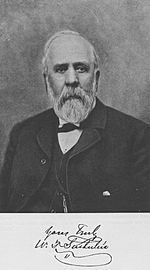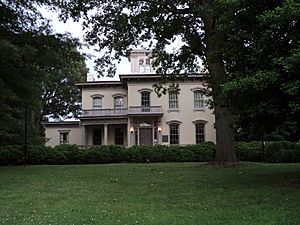William T. Sutherlin facts for kids
Quick facts for kids
William T. Sutherlin
|
|
|---|---|
 |
|
| Virginia Secession Convention of 1861 delegate | |
| Member of the Virginia House of Delegates from the Pittsylvania County district |
|
| In office December , 1871 – December , 1873 |
|
| Personal details | |
| Born |
William Thomas Sutherlin
April 7, 1822 Danville, Virginia, U.S. |
| Died | July 22, 1893 (aged 71) Danville, Virginia, U.S. |
| Military service | |
| Allegiance | |
| Branch/service | |
| Years of service | 1861–1865 |
| Rank | |
| Unit | quartermaster |
| Battles/wars | American Civil War |
William Thomas Sutherlin (born April 7, 1822 – died July 22, 1893) was an important person in Virginia during the 1800s. He was a successful tobacco farmer and businessman. He also served as a politician. Sutherlin was the mayor of Danville, Virginia from 1855 to 1861. He was also a delegate to the Virginia Secession Convention of 1861. Later, he served in the Virginia House of Delegates.
During the American Civil War, Sutherlin helped the Confederate States of America. His home in Danville became famous. It was where Jefferson Davis, the President of the Confederacy, stayed for a week in April 1865. This was just before the war ended.
Contents
Early Life and Family
William T. Sutherlin was born in 1822 in Danville, Virginia. His parents were George Sanders Sutherlin and Polly Starlings Norman. His grandfather had bought a large piece of land north of Danville in 1798. William had several brothers and sisters.
In October 1849, William T. Sutherlin married Jeanie Erwin Patrick in Greensboro, North Carolina. They had a daughter named Janine. Both his wife and daughter lived longer than he did.
Business and Public Service
William T. Sutherlin was a very active businessman. He was a farmer who grew tobacco. He also owned factories. In the 1850s, he used enslaved workers on his land and in his businesses.
Sutherlin was a leader in the tobacco industry. He found new ways to prepare tobacco for sale. He was the first person in Virginia to use steam power for tobacco presses. His tobacco factory was the second largest in the state. He also started the Bank of Danville and was its first president.
In 1855, Sutherlin was elected mayor of Danville. He served in this role for six years. In 1861, he was chosen to represent Danville at the Virginia Secession Convention of 1861. At first, he did not want Virginia to leave the United States. However, after the attack on Fort Sumter in April 1861, he changed his mind.
Role in the Civil War
William Sutherlin was in his 40s and had some health issues. Because of this, he could not fight as a soldier in the war. Instead, he was appointed as the Quartermaster of Danville. Danville was a very important place for the Confederacy. It was a major center for supplies and weapons.
Sutherlin became a Major in the Confederate army. His job was to make sure that soldiers had enough food, medicine, and weapons. He also allowed his tobacco factory to be used as a prison for captured Union soldiers.

As the war was ending in April 1865, Union troops were about to capture Richmond, Virginia. Richmond was the capital of the Confederacy. Confederate President Jefferson Davis and his team left Richmond and traveled to Danville. Major Sutherlin opened his home to them. President Davis and his cabinet stayed there from April 3 to April 10. While in Sutherlin's home, Davis wrote his last official message as President of the Confederacy. After that, he continued his journey south.
After the War
After the Civil War ended, Sutherlin continued his farming and business activities. He also stayed involved in politics. He was part of a group called the Committee of Nine. This group worked against some parts of a new state constitution proposed in 1868.
In 1871, voters in Danville and Pittsylvania County elected him. He served a two-year term as one of their representatives in the Virginia General Assembly.
Legacy
William T. Sutherlin passed away in 1893. He was buried in the family plot at Green Hill Cemetery. His important papers are kept at the University of North Carolina library.
Today, the William T. Sutherlin Mansion is a museum. It is called the Danville Museum of Fine Arts and History. The mansion is also listed on the National Register of Historic Places.

